MASTER PAL AAC Training Series: Lessons Learned
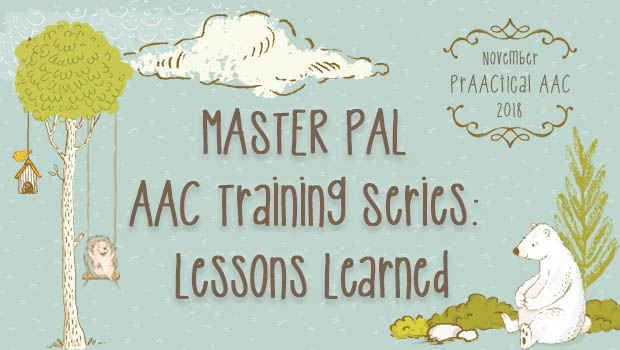
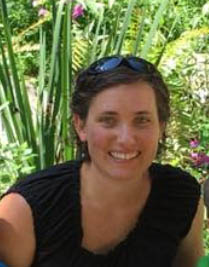 Thanks to all who reached out to express appreciation for Tabi Jones-Wohleber’s training resources in the MASTER PAL series. Many of you have already used the slides, video links, handouts, and discussion points that were shared over the past few months, and others have plans to do so. In this final post, Tabi shares some of the ‘lessons learned’ in creating and utilizing these materials.
Thanks to all who reached out to express appreciation for Tabi Jones-Wohleber’s training resources in the MASTER PAL series. Many of you have already used the slides, video links, handouts, and discussion points that were shared over the past few months, and others have plans to do so. In this final post, Tabi shares some of the ‘lessons learned’ in creating and utilizing these materials.
If you’re new to the series, you can check out each of the 11 modules here.
::::::::::::::::::::::::::::::::::::::::::::::::::::::::::::::::::::::::::::::::::::::::::::::::::::::::::::::::::::::::::::::::::;
Over the last 11 weeks, facilitation strategies for communication partners have been shared through the Model as a MASTER PAL series. Model as a MASTER PAL is a framework for supporting communication partners of those who use AAC that evolved in response to the need go beyond the imperative and always present conversations of “use core words” and “model AAC”.
It started as a list of ideas to address the subtle nuances of communication partner behaviors and belief systems. But I quickly realized that just discussing the items on the list was not fruitful. I needed meat…context, examples, rationale. So it grew. It grew into casual structured conversations with teachers and parents. Then (provided invaluable collaboration with and feedback from my teammates Trish and Kelly) it grew into highly structured PL sessions that were reproducible so that anyone with the materials could facilitate these very important conversations. This framework consists of 11 modules on the following topics (plus an introductory module).
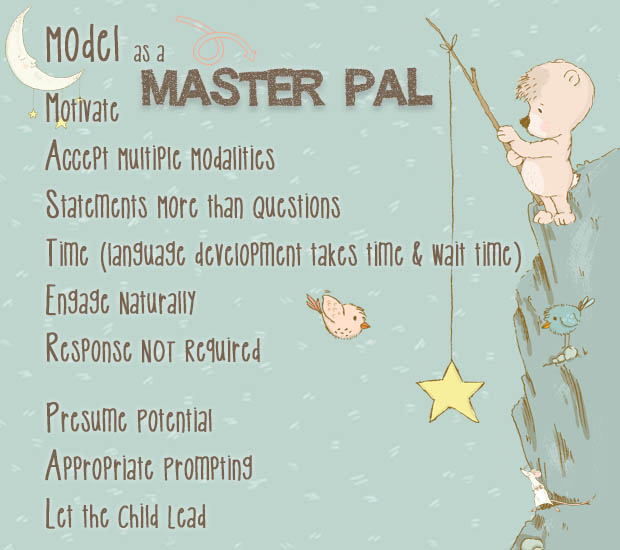
As we went through these modules in their various forms valuable lessons were learned along the way. Some called for revisions of the content or organization of activities and ideas. Others impacted how we prioritized delivery and allocated time. As you explore these resources, consider the following when you are trying to figure out how Model as a MASTER PAL can work for you:
- Modules can be shared in any order. They are complementary, but not cumulative. So if wait time is a topic that requires immediate attention in your school, then the “Time” module may be among the first your list. In fact, after “Model” I’ve started jumping straight to “Presume Potential” because it seems like a great way to lay the foundation for all the conversations that follow.
- This framework is meant to be shared over time as a form of ongoing support. This is NOT intended as a one or two day workshop that is tackled all at once. It is a means to provide depth to the AAC implementation conversation throughout the school year. It has been great for my teams that are always asking for more but want more than Core. Additionally, there is overlap between some modules because some content is relevant in various ways, AND we all know that to learn something well we need to hear it 3-5 times. Built-in redundancy (over time) for the win!
- The Warm-Up Discussions that go with almost every module set the stage for participants to relate to the topic in their own lives. It also breaks the ice and gets folks talking. The discourse that comes with the information that follows is full of openness and thoughtfulness. When time constrained, resist the urge to omit these discussions. They bring more to the interaction than you might think.
- Make it your own. There is a lot of material in the Google Slides. And the Facilitator Guidelines include additional resources. Take the liberty to use as much or as little as content as you need. I find myself always trying to fit more into less time or to offer training and support in unconventional ways. For instance, currently, I am posting MASTER PAL “spotlight” information on the back of bathroom doors throughout one of my schools.
- Allow time for discussion. Because these training modules call on folks to reflect on their own experiences and be thoughtful about how they support AAC, the need for discussion was apparent during every session. Often the most valuable thing people took away without was the ideas and problem-solving they came out of the discussions.
I am extremely appreciative of the opportunity to share Model as a MASTER PAL on PrAACtical AAC, and on Talking with Tech (awesome podcast, if you aren’t already in the know) as it has given me the opportunity to reflect on the key takeaways each module offers. After going so deep with each topic, the need for brevity became apparent to provide a snapshot of the scope of this framework to make it digestible and shareable. Take a look here. I bet you will find it useful too!!
Model as a MASTER PAL, in summary |
||
| Model | …ALL the time. We aren’t waiting for our students to prove anything. | |
| Speak your words. Use AAC. Communication is NOT an imitation task. | ||
| Motivate | …with authentic and enthusiastic interactions. | |
| Motivation is the driver in all of us. AAC can be hard. Make it worth it! | ||
|
|
Accept Multiple Modalities | …to validate communicative attempts. Teach communication is POWER! |
| Honor all modalities and respond by modeling AAC as much as possible. | ||
| Statements more than Questions | …because life is not a test. | |
| Life is not a test. Use statements (comment, describe, share information) to foster quality interactions! | ||
| Time | …for language to develop & …wait time. | |
| You can’t hurry AAC. Language takes time to develop.
AAC also requires wait time. Be a patient communication partner. |
||
| Engage Naturally | …to facilitate language and communicate respect. | |
| Genuine engagement and mutual respect are where learning happens. | ||
| Response NOT Required | …pauses without pressure facilitate comprehension. | |
| AAC supports receptive as well as expressive language.
Take off the pressure. Keep modeling. |
||
| Presume Potential | …to do no harm. Create accessible and inclusive learning and communication opportunities. | |
| There is nothing in a caterpillar that tells you it’s going to be a
butterfly.” -Buckminster Fuller |
||
| Appropriate Prompting | …to scaffold success. | |
| Prompting shapes positive practice. Independence is the goal. | ||
| Let the Child Lead | …when motivation to communicate is intrinsic, engagement will happen. | |
| Observe first. Meet the child where she is. Respond mindfully. | ||
Filed under: Featured Posts, PrAACtical Thinking
Tagged With: AAC training, downloads, MASTER PAL, partner training
This post was written by Carole Zangari


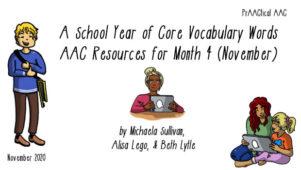
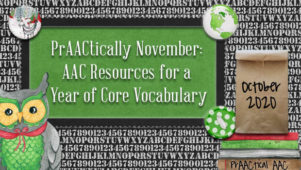
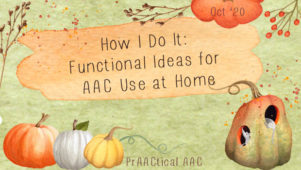
4 Comments
AMAZING training resources!!! Thank you so much for sharing!! I just used two of them (time and appropriate prompting) for a professional development workshop for our school. Facilitator notes, handouts, embedded videos, and a slide presentation-it takes a special person to share their hard work with others. Thank you for all you do!!
Awesome! I am sooo glad these were useful to you to facilitate these important conversations.
Thank you, these resources are just what I was looking for to train staff. I truly appreciate you sharing.
Thank you so much for sharing this!!!! LOVE LOVE LOVE